
Egyptian Arabic Dictionary for Android
Introduction
The Egyptian Arabic Dictionary for Android is not just a dictionary: it is an extensive collection of learning aids for students of Egyptian Arabic.
You can search for a word even if you are not sure how to spell it, you can use the regular dictionary or thesaurus with recordings of all words, you can learn vocabulary, you can see and hear example sentences, you can study Egyptian Arabic grammar, you can improve your pronunciation... you can even learn to read and write arabic!
While you are using the app, you can touch the  button at the top right of the screen to go straight to the appropriate section
of this document.
button at the top right of the screen to go straight to the appropriate section
of this document.
Even if you have used a previous version of the app, please take a few minutes to look through this guide, as there are lots of new features.
Here are four useful features that are present in some or all of the views:
Text size
Sometimes it helps to make the text larger when you want to read arabic writing. You can set the text size using the appropriate control on the settings view. Alternatively, you can use pinch and stretch gestures on most of the views
To make text bigger, place two fingers on the screen and draw them apart a little. To make text smaller, place two fingers on the screen and draw them together.
Next and Previous
On the word, example, vocabulary learning, learn arabic and write arabic views, you can go forward and back by pressing the appropriate buttons. Alternatively, you can use swipe gestures, like turning the pages of a book

To go the the next page, swipe from right to left. To go to the previous page, swipe from left to right. If your device's language is set to arabic, you swipe in the opposite direction
Players
Sometimes you have some free time to study but you don't want to, or can't, sit down and look at a screen- for example, when you are on a long journey or preparing a meal.
Note: Only use this app when driving if it is safe and legal to do so!
In the vocabulary, examples and pronunciation views, you can press the
 button to start playing a sequence of
words or examples. You can just listen quietly to the words, or practice saying them
out loud.
button to start playing a sequence of
words or examples. You can just listen quietly to the words, or practice saying them
out loud.
Unless you have a very good internet connection, we recommend that you download the appropriate sound databases before using one of the player functions.
Expand and collapse
For the word list views (search, dictionary and thesaurus), the app initially displays very brief information about each word. You can get more information about a word in two ways:
- touch the word itself to open a new word view with full details of the word. From this view to can go to the next or previous word in the list by touching the appropriate button or using a swipe gesture.
- touch any whitespace within the word entry to expand the entry:
first, you will see the words with the same meaning in the other language. Touch again to see
all of the word forms and an example sentence, if available. Touch again
or press the
 button to return to the basic word details
button to return to the basic word details
Here are examples of collapsed, partially expanded and fully expanded word.
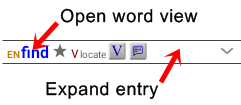 |
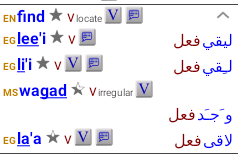 |
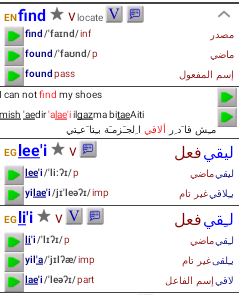 |
You can make the app always display the expanded details by changing the Expand word details option in the settings view.
Menus and Navigation
The application contains several views: you can get to many of them directly
from the main menu. If you press the menu button on your device,
you will get the main menu, which gives you access to most of views. If your
device does not have a menu button, you will see this button  in the top right of the screen.
The menu looks like this:
in the top right of the screen.
The menu looks like this:
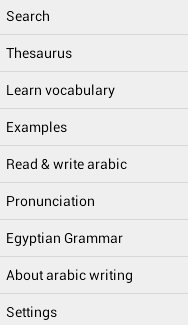
The main menu may contain more options than can be displayed on your device: if so,
you can scroll down to see the last few items. You can return to the previous view at any time by pressing the  button.
button.
Main view buttons
On most views, there are also buttons in the top right to access the main views. The view buttons look like this:
 - Search
- Search - Dictionary
- Dictionary - Thesaurus
- Thesaurus - Learn vocabulary
- Learn vocabulary - Example arabic sentences
- Example arabic sentences - Application help
- Application help
Word Menu
When you are looking at one of the main views, if you long-touch a word, the app will display the word menu, which looks like this:
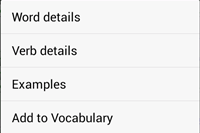
You can touch one of the the first three items to open up a new view, or on the last option to add the selected word to your personal vocabulary list.
Note: A short touch normally opens the Word Details view: if you find the word menu more useful than the Word Details view, you can change the 'Short touch for word menu' setting to make a short touch open the word menu.
Element Menu
When you are looking at one of the main views, if you touch a grammatical element (for example n for noun), the app will display the element menu, which looks like this:

You can either go to the appropriate section in the Egyptian Arabic grammar, or you can see example sentences that use this type of word.
Additional information
If you touch on a language code or a usage star, you will see an explanation of what the code or symbol means.
Views
The app has ten information views: the first eight of them are accessed from the menu, and the other two by touching words in other views.
- Search - look for a word in one language, even if you don't know exactly how to spell it, and see translations to the other language
- Dictionary - See a list of words arranged alphabetically, like a normal dictionary
- Thesaurus - see a list of words with similar meanings, for example, there is a section for foods and a sub-section for herbs.
- Vocabulary - Use this view to help you learn your personal selection of words
- Pronunciation - Use this view to improve your pronunciation
- Read Arabic - Learn to read and write arabic
- Grammar - A comprehensive summary of Egyptian arabic grammar
- Examples - see examples sentences
- Word Details - see full details for a selected word
- Verb Details - See all tenses and all cases of a verb
There are nine other views - five accessible from the main menu, two from the vocabulary view and two from the Read arabic view:
- Settings - set display options, eg text size and arabic display mode
- Vocab add - select and add words to your personal vocabulary list
- Vocab player - test your vocabulary knowledge with spoken questions and answers
- Read Arabic - writing - Practice reading and writing arabic
- Read Arabic - options - Options for the read and write arabic views
- Download updates and sounds - Check for updates and download the entire sound database for a language
- Help - this guide to using the app
- Arabic writing - An introduction to arabic writing and explains how arabic words are written in european letters in the dictionary
- About - Version and web site information
Search
This view appears when you start the application. You can also get to it using the main view buttons or the main menu.
When you type in a word, the search view displays about ten words in one language (the source language) that are similar in spelling to the word that you entered. If you touch on a word entry, you will also see the details for the words in the other language that have the same meaning.

First, you should select the source language and the keyboard type. Next, type in a word, or part of a word, to look for. You don't need to spell it exactly: in the next stage, the app will display a selection of the most similar words.
You can select the keyboard type using the control next to the language. The options are:
 - Android keyboard - either
a real keyboard if your device has one, or the normal on-screen keyboard.
- Android keyboard - either
a real keyboard if your device has one, or the normal on-screen keyboard. - english app keyboard
- english app keyboard - transliterated arabic app keyboard
- transliterated arabic app keyboard - arabic app keyboard
- arabic app keyboard
The android keyboard is the best choice when you want to enter a word your own language. You will probably find the app keyboard easier for the other language: the keys are laid out in straight alphabetical order, so that it's easier for english people to find letters on the egyptian keyboard and vice versa. The app will remember your selection for each language.
The app keyboard comes in three forms, depending on the selected language. It will look like this:
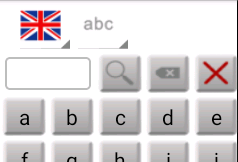
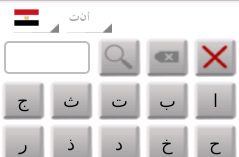
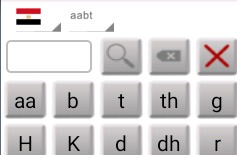
If the source language is  Egyptian, you have two choices of keyboard -
Egyptian, you have two choices of keyboard -  arabic or
arabic or  transliterated. English users may be surprised to see
that there are no short vowels: this is normal when writing arabic. It is not a
problem, though: for example, typing in ktb will find
both kitab and kutub
transliterated. English users may be surprised to see
that there are no short vowels: this is normal when writing arabic. It is not a
problem, though: for example, typing in ktb will find
both kitab and kutub
When using the app keyboard, the following controls are available:
 - press this to see the search results
- press this to see the search results - backspace to remove the previous letter
- backspace to remove the previous letter - delete the whole word
- delete the whole word
When you touch the  button, the app
displays up to twenty words that are the closest match to the word that you entered:
button, the app
displays up to twenty words that are the closest match to the word that you entered:
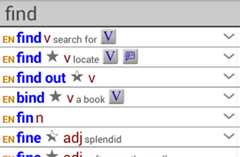
Normally, the app displays the details for each word in a collapsed form. To see more information about the word, you can either touch the word itself to open a word view or touch any whitespace within the word entry to expand the word. See expand & collapse for more information.
Egyptian words and forms will appear in transliterated or pronounced form on the left and in arabic on the right. Use settings to adjust the way that the information is presented.
For each search word or meaning, the app displays the following details:

| Item | Example | Touch |
| language code | EN | see the full name eg English |
| word | find | short touch: open the word view long touch: open the word menu |
| usage |  | see the a description of the usage |
| verb info (if available) |  | open the verb view |
| examples (if available) |  | go to the examples view |
| element code | v | open the element menu |
| notes | locate |
The usage is a star indicating how frequently the word is used: the options are
 - daily
- daily - regularly
- regularly - occasionally
- occasionally - understood but rarely used
- understood but rarely used - not always understood
- not always understood- no star - unrated
For each grammatical form of a word (eg singular and plural), the app displays:

| Item | Example | Touch |
| play button |  | hear the word |
| word | found | |
| word in phonetic writing | /ˈfaund/ | |
| form code | p | see full name eg perfect |
| notes |
When fully expanded, you will also see an example sentence (if available) with the word highlighted and the thesaurus category, eg intellect: search. Touch the thesaurus category to open the thesaurus view, where you will find a list of similar or related words
Dictionary
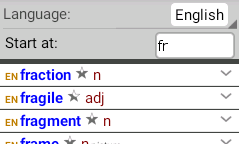
The dictionary provides you with an alphabetical list of words, like a normal dictionary. You can look for a word in one language, and then see corresponding words in the other language. If you are not sure exactly how to spell a word, or you just need to look something up quickly, you may find that the search view is more effective.
You can get to the dictionary view from the main menu, or by touching on the dictionary button at the top of the screen.

At the top of the screen, there are two controls:
- Language - words in this language are shown in alphabetical order
- Start at - Type in one or more letters to go straight to the first word beginning with these letters
You will see a list of words in the selected language: you can scroll up and down through the list of words in the usual way. The information provided is in the same format as the search results

Normally, the app displays the details for each word in a collapsed form. To see more information about the word, you can either touch the word itself to open a word view or touch any whitespace within the word entry to expand the word. See expand & collapse for more information.
Thesaurus
You can get to the thesaurus from the main menu, or by touching on a thesaurus category in any of the other views.
The thesaurus view shows you lists of words with similar or related meanings.
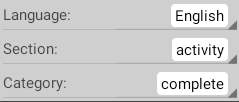
At the top of the screen, there are three controls. If you came here by touching a thesaurus category, these controls will be set with the details of the category that you touched.
- Language - the source language for the thesaurus
- Section - select the section, eg food, which contains a number of categories
- Category - select a category, eg fruit, which contains several of words with similar or related meanings
When you change the section, the options in the category list will change accordingly. When you select a new category, the app displays a list of words in the source language. The information provided is in the same format as the search results.
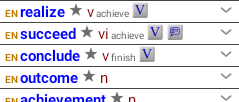
Normally, the app displays the details for each word in a collapsed form. To see more information about the word, you can either touch the word itself to open a word view or touch any whitespace within the word entry to expand the word. See expand & collapse for more information.
Learn vocabulary
You can get to the vocabulary view from the main menu.
This view helps you to learn a list of words that you have selected. It uses the spaced repetition system to ensure efficient learning of new words: after you have seen the answer to a word, you rate your answer between 1 (not a clue) and 5 (perfect). Words that you rate as perfect move to the back of the list, so that you can concentrate on words that you are less familiar with.
If you have some time to study, but don't want to sit staring at the screen, you can press
the  button to switch to the vocabulary player view.
button to switch to the vocabulary player view.
If you find an interesting word in one of the other views, you can add it to your
vocabulary list by touching the word and then
selecting add to vocabulary from the menu. Alternatively, you can
select and add several words using the
 button at the top
left of this view.
button at the top
left of this view.
For each selected word, the app displays the meaning in the other language, and asks you what the word is:
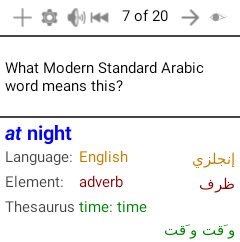
When you think that you know the answer, touch
 or use
a swipe gesture to find out whether
you were right.
or use
a swipe gesture to find out whether
you were right.
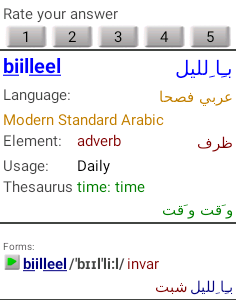
The app shows you full details of the word that you are trying to learn, in the same layout as the word details view.
Check your answer, and then rate it between 1 and 5 by pressing one of the buttons above the word. 1 means that you didn't have a clue, and 5 means that you remembered it easily, quickly and perfectly.
You can also use a swipe gesture to see the answer or move on to the next word. The swipe gesture is treated as one of the rating buttons: You can set the swipe rating in the vocab options view
Vocabulary controls

The  button
takes you to the Add vocabulary view: here,
You can select a time range for words to review, and various other features.
button
takes you to the Add vocabulary view: here,
You can select a time range for words to review, and various other features.
The  button
takes you to the Vocabulary player view: here,
you can listen and reply to questions about the selected vocabulary words.
button
takes you to the Vocabulary player view: here,
you can listen and reply to questions about the selected vocabulary words.
The  button
takes you to the Vocabulary options view: here,
You can select a time range for words to review, and various other features.
button
takes you to the Vocabulary options view: here,
You can select a time range for words to review, and various other features.
The  button
takes you back to the previous word.
button
takes you back to the previous word.
If you press the  button,
the current word will be hidden. If show hidden words is not selected,
the word will not be shown in the vocabulary view. If you press it accidentally, you
can get the word back by turning on show hidden words, finding the
word and pressing the
button,
the current word will be hidden. If show hidden words is not selected,
the word will not be shown in the vocabulary view. If you press it accidentally, you
can get the word back by turning on show hidden words, finding the
word and pressing the  button
button
Vocabulary player
The vocabulary player is accessed by pressing the
 button on one of the
other vocabulary views.
button on one of the
other vocabulary views.
It is useful when you have time to study but don't want to look at the screen. It uses the speaker or earphones to ask you a question, for example "what does this word mean?". It gives you time to think, then tells you the answer. It can also say any example sentences for the word and their meanings.
The app also displays the same details of the current word as the vocab
learning view, in case you need to get any additional information. You can press the
 button if you need more time,
or if you need to attend to something else temporarily.
button if you need more time,
or if you need to attend to something else temporarily.
See the Vocabulary options view for details of the various settings that you can change to suit your needs.
Vocabulary options
You can get to the Vocabulary options view by touching the
 button
in the Learn vocabulary or Vocabulary player views.
button
in the Learn vocabulary or Vocabulary player views.
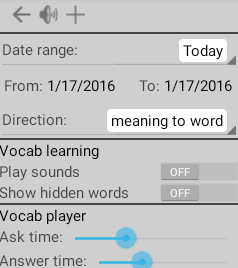
General options
Date range
You will normally want to concentrate on words that you have added today, and then revise words added over the past couple of days or maybe over the past week. Occasionally you may want to look further back. There are are several fixed options (today, yesterday, last week, etc) or, if you select the last option Specify dates..., you can select whatever date range you wish.
Direction
The app normally displays a meaning and asks you for the word. Sometimes it is useful to reverse the process- the app shows the word, and you have to remember what it means.
Learning options
The following options only have an effect in the vocabulary learning view:
Play sounds
If you select this option, when the app shows you the word, it also plays a recording of somebody saying the word.
Show hidden words
If you have hidden some words, you can see what words you have hidden (and un-hide them again if you want) by using this option.
Swipe rating
You can move onto the next word using a swipe gesture, rather than by pressing one of the rating buttons. You can use this option to specify what rating to apply when you use a swipe gesture to go to the next word.
If you are looking through some words for the first time, you can set the swipe rating to zero or one, then press one of the other rating buttons when you come across a word that you do know. Similarly, when revising and you know most of the words, you can set the rating to 4 or 5.
Player options
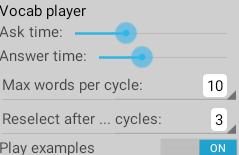
The following options only have an effect in Vocabulary Player view:
Ask time
This is the time, in seconds, that the app waits after asking a question before telling you the answer.
Answer time
This is the time, in seconds, that the app waits after telling you the answer before asking the next question
Max words per cycle
If you have a lot of free time, for example on a long journey, you might want to set the time range to select all words in your vocabulary. It's not very effective, though, to just hear a word once, then maybe again in another hour. The player can randomly select a small number of words from the words in your selected date range and then repeat them a certain number of times (see the next item) before selecting a different set of words.
This option specifies how many words to select for each cycle.
Reselect after ... cycles
This option specifies how many times to go through the selected set of words before selecting a new set.
Play examples
Once the app has told you the answer, it can read out some of the example sentences that use the word. If don't find this feature helpful, you can turn it off.
Add Vocabulary
You can get to the Add Vocabulary view by touching the
 button
in one of the other vocabulary views.
button
in one of the other vocabulary views.
You can use this view to add a number of words to your personal vocabulary
list. Remember that you can also add words to your vocabulary
list by touching a word to go to the word view, then touching
the  button in the top right of the screen.
You can also long-touch a word and then select add to vocabulary.
button in the top right of the screen.
You can also long-touch a word and then select add to vocabulary.
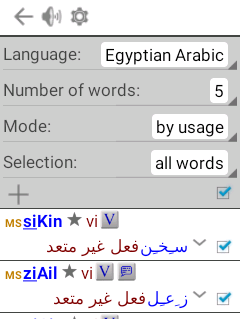
The following options are available to select words:
- Language - select the language that you want to add words in: this will probably be the language that you are learning.
- Number of words - the number of words to add: most people find that they can learn five or ten new words a day.
- Mode - the app can select the most widely used words, or randomly
- Selection - all words, thesaurus category (eg foods: fruit) or grammatical element (eg adverbs)
Depending on the selection method, the app may also display options to specify the thesaurus section and category, or the grammatical element.
The app displays the words that you have selected in the lower part of the
display, with a  checkbox
next to each word. You can use the chckbox next to a word to select or
de-select that individual word, or you can use the checkbox at the
top to select or de-select all of the words.
checkbox
next to each word. You can use the chckbox next to a word to select or
de-select that individual word, or you can use the checkbox at the
top to select or de-select all of the words.
Once you are happy with the selection, press the
 button at the bottom
right of the control area. The app then confirms that the words have been added. If
you want to add more words with the same settings, press the
button at the bottom
right of the control area. The app then confirms that the words have been added. If
you want to add more words with the same settings, press the
 button to select
some more words to add.
button to select
some more words to add.
Read Arabic- learn
You can get to the Read Arabic- Learning view from the main menu
The Read Arabic- Learning view is the first stage of learning to read and write arabic. It shows you the details for each of the letters used in Egyptian arabic. The letters are divided into ten groups of four to six letters. If you learn one group of letters every day, you will have learned the entire alphabet after just ten days!
If you are more comfortable learning from a fixed document, or you want to learn a little about arabic writing before you get started, check out the arabic writing view, which is accessible from the main menu.
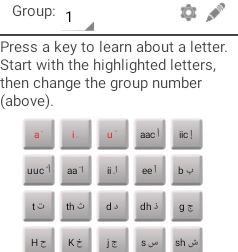
At the top of the screen, you can select the group of letters that you want to learn. It's best if you start with group one on the first day, group two on the second day, etc.
Below this is a keyboard: the currently selected group is highlighted. When you touch a key, the app gives you information about this letter and examples of words that contain the letter. The following details are displayed:
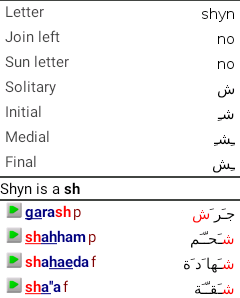
- the name of the letter
- whether the letter joins to the next letter on the left
- whether it is a sun letter
- whether it tashkyl
- how to write the letter on its own and at end of a word. If it joins left, there will also be a start and middle form
- a description of the letter
- ten example words that show what the letter looks like in a word: the selected letter appears in red in each word.
The example words are different each time, so it is worth while clicking on each letter more than once.
You can click on the  button next to an example word,
to hear somebody saying the word.
button next to an example word,
to hear somebody saying the word.
You can press another button to see the details for another letter, or you can use a swipe gesture to go to the next or previous letter on the keyboard.
Read Arabic- write
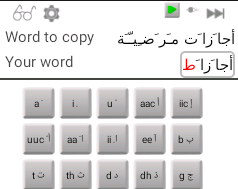
You can get to the Read arabic- write view by pressing the
 button on the Read
Arabic-Learn view.
button on the Read
Arabic-Learn view.
The Read Arabic- write view gives you an opportunity to test your arabic reading and writing skills. It shows you a randomly selected word, and you then type in the word using the app keyboard. The android keyboard is not suitable because it does not support tashkyl. You can use the Read Arabic- options view to adjust the difficulty level.
As you type letters, your letters appear on the screen below the word that you are supposed to write. If a letter is correct, it appears in green: if you make a mistake, the letter appears in red. You can use the backspace key to try again, if you wish.
When you have completed a word, you can press the
 button or use
a swipe gesture to select another word.
button or use
a swipe gesture to select another word.
Read & write arabic - Options
You can get to the Read Arabic- Options view by touching the
 button on the Read
Arabic-Learn view.
button on the Read
Arabic-Learn view.
The read arabic- options view enables you to select the difficulty level for the writing view. You can either select typical settings for beginner, intermediate or advanced using the buttons at the top, or you can specify exactly what you want using the options below.
Show transliterated/arabic
You can show arabic letters, transliterated letters or both on the keys. This affects both the reading and writing tabs.
Play sound
When writing, there will be a  button next to the
word: you can click on it to hear somebody speaking the word.
button next to the
word: you can click on it to hear somebody speaking the word.
If you select this option, you will also hear the recording as soon as the word is displayed.
Show word
This option specifies whether the word is displayed, and for how long. You can improve your reading ability by displaying the word for just a short time, then trying to write the word from memory. If you are an expert, you can hide the word completely, and just listen to the recording. The options are:
- show the word all the time
- show the word until you type the first letter
- show the word for five seconds only
- don't show the word at all
You can manually show or hide the word at any time using the tick/cross button next to the word.
Hints
If you want to start writing before you have finished learning all of the letters, you can turn on hints. When you reach a letter that you have not yet learned, based on the group number, the app highlights the key for this letter.
Pronunciation
You can get to the Pronunciation view from the main menu
The pronunciation view shows you several words containing a selected phoneme (sound) or sequence of letters
When you touch a word, you will hear somebody saying the word. In addition, you can record yourself saying the word, then compare your version with the correct version.
Alternatively, if you don't want to sit staring at the screen, you can touch the
 button to start the player function, which will start saying the words in the list automatically:
there is a pause after each word, so you can practice saying the word yourself.
button to start the player function, which will start saying the words in the list automatically:
there is a pause after each word, so you can practice saying the word yourself.
Selection area
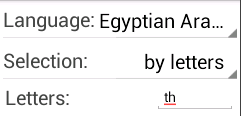
At the top of the display is the selection area: you can use this to select the language and the group of letters that you want to practice saying.
Language
This specifies the language that you want to practice.
Selection
You can select the list of words that you want to practice in two ways:
- for a phoneme (sound)
- for a sequence of letters
Letters to listen to
This field is only visible if you have set the selection to by letters. Enter a letter or group of letters. When you type something in, the app will show you a some words containing this group of letters. The letters must be in the sequence that you specified, so ie will match words containing ie but not words containing ei. The selected letters are highlighted in each word. Each time you select a letter combination, you will see a different, randomly selected, set of words.
Phoneme
This field is only visible if you have set the selection to by phoneme. On tablets, it appears at the left of the screen rather than in the selection area. When you select a phoneme, the app will show you a selection of words containing this phoneme. The selected phoneme is highlighted in each word. Each time you select a letter combination, you will see a different, randomly selected, set of words.
 button
button
You can use this button to hear what YOU sound like when you say a word. When you click on it, the app starts recording for two seconds. During recording, it shows you a volume bar: the louder you speak, the brighter green it gets. If it goes red, that means that you are too loud.
 button
button
There are two play buttons. The bottom one appears once you have recorded a word: if you press it, you will hear yourself again. The top one plays the correct pronunciation of the current word again.
Current word
When you click on a word in the word list, the word is displayed here.
Phoneme List
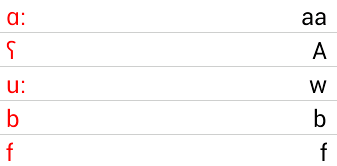
If you are using a tablet, a list of phonemes appears on the left of the screen. This contains all of the phonemes that are ever used in the selected language. If you are selecting by phoneme, you can click on a phoneme to see a list of words containing that phoneme.
The list contains the following columns:
- phoneme: The phoneme. The phonemes are divided into different coloured groups.
- examples: some of the letter sequences that are used to write this phoneme.
Word List
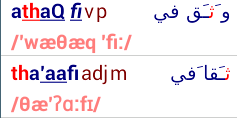
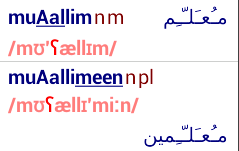
The word list contains a selection of words containing the phoneme or group of letters that you specified. The selected phoneme or letters will be highlighted in each word. When you click on a word, you will hear a recording of somebody saying the word. The word will also appear in the current word box above.
The list contains the following columns:
- word: the word itself. If you are selecting words using a letter sequence, the sequence will be highlighted in red.
- form: the grammatical element and form of this word. For example, n s means the singular form of a noun.
- phonemes: the word written phonetically. This is not available for all english words. If you are selecting words by phoneme, the selected phoneme will be highlighted in red.
Word details
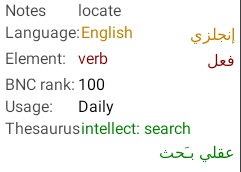
You can get to this view by touching on a word (not a form) in one of the other views. It displays full details of the selected word.

If you came to this view from a word list (the search, thesaurus or dictionary views), you can go to the next or previous word in the list by touching the appropriate button or by using a swipe gesture.
The following details are displayed:

- word
- language
- element - for example, noun
- usage - how frequently the word is used.
- For English words, the British National Corpus rank- the lower the number, the more frequently used the word is
- notes
- flags - eg impolite
- thesaurus category
The app displays a list of grammatical forms for the selected word, followed by a list of meanings. This information is in the same layout as the search results.
Next, it displays any example sentences that contain the word, with the word and its corresponding meaning highlighted. Finally, it gives you a list of words with similar spellings.
At the top right are up to three buttons. A button is not displayed if the corresponding function is not available for this word. For example, the Add to vocabulary button is not displayed if the word is already in your personal vocabulary list. The buttons are:
 - open the verb details view to show details for this word
- open the verb details view to show details for this word - open the examples view to show examples for this word
- open the examples view to show examples for this word - add this word to your personal vocabulary list
- add this word to your personal vocabulary list
Verb details
You can get to this view by touching the  button next to a word,
long-touching a word (not a form) and then selecting Verb details from
the word menu, or by pressing the
button next to a word,
long-touching a word (not a form) and then selecting Verb details from
the word menu, or by pressing the  verb
button in the Word view. If you do not see Verb details in the menu, this
could be because the word is not a verb, or the app does not know how to decline
it (about 90% of verbs are covered).
verb
button in the Word view. If you do not see Verb details in the menu, this
could be because the word is not a verb, or the app does not know how to decline
it (about 90% of verbs are covered).
This view displays full details of all cases of the main tenses of the verb.

At the top of the screen, the app displays the verb itself. If there is more than one meaning, it also lets you select the meaning to display.
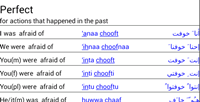
Below this, the app displays full details of all cases of the main tenses of the verb. Note that this information is generated automatically: a word's presence does not necessarily mean that the word is, or can, be used- for example 'he became pregnant' is syntactically correct but useless. Please check the grammar view for general guidelines, and also use a little common sense.
Examples
This view shows example sentences in Egyptian Arabic.
You can get to this view in three ways:
- see all examples: open the main menu and select Examples
- see the examples for a particular word: touch the
 button next to a word
or press the
button next to a word
or press the  button in the word view.
button in the word view. - see the examples for a grammatical element: touch the element next to a word, eg prep, and then select Examples from the element menu.
If you do not see the Examples option in the word menu, this means that there are no examples for the selected word.

At the top of the display, you can specify whether you want to see all examples, or just ones of a particular difficulty level- simple, average or difficult.
Below this the app shows the number of selected examples and the number of the current example.
You can go through the examples using the forward
 and
back
and
back  buttons:
you can also go to the next or previous example using a swipe gesture.
If there are more than ten examples, there is also a slider control to move quickly through the examples.
buttons:
you can also go to the next or previous example using a swipe gesture.
If there are more than ten examples, there is also a slider control to move quickly through the examples.
Alternatively, if you don't want to sit watching the screen, you can press the
 button to start the player: this will select an example every few seconds, and
say the example and its translation. The information is still displayed on the screen,
so if you hear something that you don't understand, you can hit the
button to start the player: this will select an example every few seconds, and
say the example and its translation. The information is still displayed on the screen,
so if you hear something that you don't understand, you can hit the
 button and then
check the details
button and then
check the details
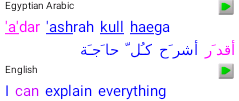
Below this, the app displays the example in european writing and arabic. One of the words is highlighted. The details of this word are shown below, in the same layout as the word view. The corresponding word in the other langauage is also highlighted. You touch on any other word in the example or the translation to highlight it.
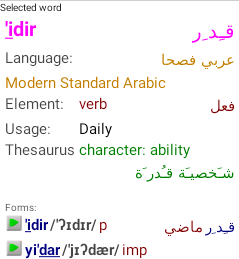
Note that some words have no translation in the other language, for others, the implied meaning is not the same as the literal meaning. In either case, no corresponding word will be highlighted.
You can press one of the  buttons to hear somebody saying the example sentence or the translation.
buttons to hear somebody saying the example sentence or the translation.
Settings
This view can be used to adjust how information is displayed throughout the other views in the application.
General settings
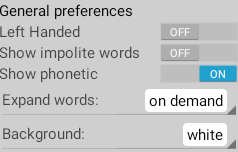
Left handed
If you use a tablet and are left handed, you will probably find it annoying to have to reach across to the right hand side of the screen to press the buttons. If you select Left handed, the most useful buttons are moved to the left of the display.
Show impolite words
Turn this on if you don't mind seeing offensive words.
Short touch for word menu
Normally, a short touch on a word opens the Word Details view and a long touch opens the Word Menu. If you find the Word menu more useful, you can use this setting to make a short touch open the Word Menu as well.
Background
The control area for each view is always grey, but you can select a white or a black background for the information area.
Show phonetic
Turn this on to see the word in phonetic writing in addition to any other forms. This is available for most arabic words and some English words.
Expand word details
This specifies how the word details appear in the search results. The options are:
- never: the words are always collapsed- the minumum details are displayed
- on demand: the words are initially collapsed: you can touch the expand button to see the full details
- always: the words are always expanded - all details are displayed. If you select this option, it may take some time to update the screen.
Arabic writing settings
This group of settings affects how arabic writing is displayed. The app displays some sample Egyptian arabic words so that you can see what they will look like with the current settings.
See the arabic writing view for more information about the transliterated and pronounced arabic, and about tashkyl.
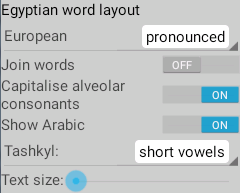
European
Arabic words are normally displayed in european writing on the left of the display. You can hide this completely, show a transliterated form or a pronounced form.
Join words
When putting two words together produces three consonants in a row, Egyptians insert a schwa- an 'uh' sound- between the words. If you select pronounced european writing, enabling this option will insert a schwa where necessary. Some people may find that this makes the words more difficult to read.
Capitalise alveolar consonants
In the pronounced form, alveolar consonants can be written in lower case letters or in capitals. Lower case is easier to read for beginners, but you cannot see the difference between the normal and alveolar consonants, for example ss س (syn) and SS ص (saad).
Arabic
Egyptian words are normally displayed in arabic writing on the right of the display. If you find this distracting, you can hide it.
Tashkyl
Normally, arabic is written without tashkyl (short vowels), but this is not very helpful to non-arabic speakers. Within the app, you can select no tashkyl, with short vowels or with short vowels and sukun. Sukun is a symbol that indicates that there is no vowel between two consonants.
Text size
Most europeans (and some Egyptians!) find arabic writing a bit small: use this option to adjust the text size to suit your taste. It also affects the size of european writing. You can also change the text size using pinch and stretch gestures
Download updates and sounds
You can get to this view by selecting Download updates and sounds from the main menu.
You can use this view to check for updates to the app, the word database or the grammar, and to download a sound database- either for a language or for the egyptian arabic grammar.
Please make sure that your device is fully charged, or the charger is plugged in, before you start.
App updates
If there is a new version of the app available, you will need to update it using Google Play before you can download any word or sound databases
Word database and grammar updates
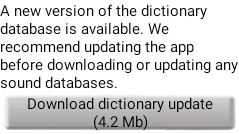
If there is a new version of the word database or grammar that is compatible with your current app version, you will need to download this update before you can download any sound databases. Just click on the big button to start the download.
Sound Databases
In all of the other views, if there is a  play
button next to a word form, you can touch it to hear the word form spoken.
play
button next to a word form, you can touch it to hear the word form spoken.
The app can handle the sounds in two ways: you can either download a database containing all of the sounds for a language, or the app can fetch individual sounds from the internet as required.
The former takes up space on your device but, once you have downloaded the sound database, playing sounds is immediate and it will work even when you don't have an internet connection.
If you have already downloaded a sound database for a language, the app will just download a small update which will be added to the existing sound database: adding the new sounds will take a few seconds once the download is completed.

For each language, there is either a  button- click on this to start the download- or OK which means that the
sound database for this language is up to date.
button- click on this to start the download- or OK which means that the
sound database for this language is up to date.
Once you have started the download, if you are not planning to do anything until the download is completed, just leave it showing the download status: like this, the device will not go to sleep until the download is completed. If you want to use the dictionary, that's ok, as the download will continue in the background- but don't exit the application, or the download will be cancelled.
Grammar
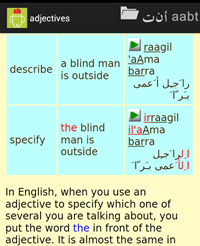
You can get to this view by selecting Grammar from the main menu, or by touching a grammatical element (eg noun) in one of the main views and then selecting grammar from the element menu.
This view offers a comprehensive summary of Egyptian Arabic grammar. It works like a web browser, and you can follow links between the chapters.
There are lots of examples, and you press the  button to hear
somebody saying the examples.
button to hear
somebody saying the examples.
There are four buttons in the action bar at the top right: you can use them to navigate around the grammar and to select how you want arabic examples to be displayed. The buttons are:
 - go to the contents page of the grammar
- go to the contents page of the grammar - turns the arabic-writing version of the examples on or off
- turns the arabic-writing version of the examples on or off - switches the european-writing version of the examples between transliterated and pronounced
- switches the european-writing version of the examples between transliterated and pronounced - go to the next chapter
- go to the next chapter
While you are using the dictionary, you can go directly to the right place in the grammar by touching a grammatical element code (eg v for verb) for a word in any of the main views.
About arabic writing
You can get to this view by selecting arabic writing from the main menu.
This view gives an introduction to arabic writing, and explains how arabic
words are written using european letters in the dictionary. You can touch
the  button for each arabic letter to hear somebody
saying example words containing that arabic letter. It also gives a full description of the
pronunciation rules for Egyptian Arabic.
button for each arabic letter to hear somebody
saying example words containing that arabic letter. It also gives a full description of the
pronunciation rules for Egyptian Arabic.
If you want to learn to read and write arabic, see the Read & Write Arabic menu option.
About
This view contains the version, copyright notice and web site name for this application.
Arabic terms
This section contains a few notes that explain some of the terms mentioned in the Read & Write Arabic views. For more detailed information about arabic writing and pronunciation, see the About arabic writing menu option.
There are officially 28 letters in the arabic alphabet: in addition to this, there are several additional symbols that are used one their own or combined with the letters, giving a total of 46 letters.
Join left
Writing goes from right to left, and the majority of arabic letters join onto the following letter and so there are therefore four forms of each letter: solitary, initial, middle and final. For the six letters that do not join, there are just two forms- solitary and final.
| position | normal letter | non-joining letter |
| solitary | ج | د |
| initial | جـ | |
| middle | ـجـ | |
| final | ـج | ـد |
Tashkyl
The three short vowels aa َ, ii ِ and uu ُ and shadda ّ, which doubles the length of a consonant, are collectively called tashkeeltashkyl تـَشكيل or vowellization. Tashkyl is not normally used in written arabic apart from in the Quran. If they are used, they are written above a consonant but pronounced after it: for the convenience of non-arabic readers, I have included the tashkyl, but written it after the consonant.
Sun letters
If the definite article, il-iil_ ا ِلـ, is attached to a word that begins with a sun-letter (t s sh d z r z S D T Z nt s sh d dh r z S D T Z n ت س ش د ذ ر ز ص ض ط ظ ن) the l is dropped and the sun-letter is doubled: